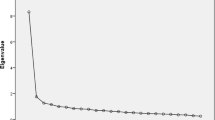Abstract
The Social Phobia and Anxiety Inventory (SPAI) is a new instrument designed to assess symptoms of social phobia. Although the scale has been shown to have a good test-retest reliability, internal consistency, and construct validity, no studies have examined its concurrent validity with respect to other measures of social anxiety and avoidance. In the present study, the relationship between the SPAI and several self-report measures of social anxiety was examined in a sample of 23 patients meeting DSM-III-R criteria for social phobia. The relationship between the SPAI and other measures of psychopathology, as well as performance during a role play test and an impromptu speech, was also examined. The results strongly support the concurrent validity and the specificity of the SPAI. The Social Phobia subscale may be a better index of social anxiety symptoms than the Difference subscale.
Similar content being viewed by others
References
American Psychiatric Association (1980).Diagnostic and statistical manual of mental disorders (3rd ed.) Washington, DC: APA.
Arrindell, W. A., Emmelkamp, P. M. G., & van der Ende, J. (1984). Phobic dimensions: I. Reliability and generalizability across samples, gender and nations.Advances in Behavioral Research and Therapy, 6, 207–254.
Beck, A. T., & Steer, R. A. (1988). Psychometric properties of the Beck Depression Inventory: Twenty-five years of evaluation.Clinical Psychology Review, 8, 77–100.
Beck, A. T., Ward, C. H., Mendelson, M., Mock, J., & Erbaugh, J. (1961). An inventory for measuring depression.Archives of General Psychiatry, 4, 561–571.
Beidel, D. C., Borden, J. W., Turner, S. M., & Jacob, R. G. (1989). The Social Phobia and Anxiety Inventory: Concurrent validity with a clinical sample.Behaviour Research and Therapy, 27, 573–576.
Beidel, D. C., Turner, S. M., Stanley, M. A., & Dancu, C. V. (1989). The Social Phobia and Anxiety Inventory: Concurrent and external validity.Behavior Therapy, 20, 417–427.
Derogatis, L. R. (1983).SCL-90-R administration. scoring and procedures manual—11 for the revised version. Baltimore, MD: Clinical Psychometric Research.
DiNardo, P. A., & Barlow, D. H. (1988).Anxiety Disorders Interview Schedule—Revised. Albany Center for Stress and Anxiety Disorders, University at Albany, State University of New York.
Goldfried, M. R., & D'Zurilla, T. J. (1969). A behavioral-analytic model for assessing competence. In C. D. Spielberger (Ed.),Current topics in clinical psychology (Vol. 1, pp. 151–196). New York: Academic Press.
Heimberg, R. G., Hope, D. A., Rapee, R. M., & Bruch, M. A. (1988). The validity of the Social Avoidance and Distress Scale and the Fear of Negative Evaluation Scale with social phobic patients.Behaviour Research and Therapy, 26, 407–410.
Heimberg, R. G., Dodge, C. S., Hope, D. A., Kennedy, C. R., Zollo, L. J., & Becker, R. E. (1990). Cognitive behavioral group treatment for social phobia: Comparison with a credible placebo control.Cognitive Therapy and Research, 14, 1–23.
Lang, P. J. (1977). Physiological assessment of anxiety and fear. In J. D. Cone & R. P. Hawkins (Eds.),Behavioral assessment: New directions in clinical psychology (pp. 178–195). New York: Brunner/Mazel.
Leary, M. R. (1983). Social anxiousness: The construct and its measurement.Journal of Personality Assessment, 47, 66–75.
Liebowitz, M. R. (1987). Social phobia.Modern Problems in Pharmacopsychiatry, 22, 141–173.
Liebowitz, M. R., Gorman, J. M., Fyer, A. J., & Klein, D. F. (1985). Social phobia: Review of a neglected anxiety disorder.Archives of General Psychiatry, 42, 729–736.
Mannuzza, S., Fyer, A. J., Liebowitz, M. R., & Klein, D. F. (1990). Delineating the boundaries of social phobia: Its relationship to panic disorder and agoraphobia.Journal of Anxiety Disorders, 4, 41–59.
Marks, I. M., & Mathews, A. M. (1979). Brief standard self-rating for phobic patients.Behaviour Research and Therapy, 17, 263–267.
Reich, J., & Yates, W. (1988). A pilot study of treatment of social phobia with alprazolam.American Journal of Psychiatry, 145, 590–594
Spielberger, C. D. (1983).Manual for the State-Trait Anxiety Inventory (revised ed.). Palo Alto, CA: Consulting Psychologists Press.
Spielberger, C. D., & Vagg, P. R. (1984). Psychometric properties of the STAI: A reply to Ramanaiah, Franzen, and Schill.Journal of Personality Assessment, 48, 95–97.
Spitzer, R. L., Williams, J. B. W., Gibbon, M., & First, M. B. (1989).Structured Clinical Interview for DSM-III-R. Unpublished manuscript. New York State Psychiatric Institute.
Stravynski, A., Marks, I., & Yule, W. (1982). Social skills problems in neurotic outpatients.Archives of General Psychiatry, 39, 1378–1385.
Turner, S. M., & Beidel, D. C. (1988). Some further comments on the measurement of social phobia.Behaviour Research and Therapy, 26, 411–413.
Turner, S. M., McCanna, M., & Beidel, D. C. (1987). Validity of the Social Avoidance and Distress and Fear of Negative Evaluation scales.Behaviour Research and Therapy, 25, 113–115.
Turner, S. M., Beidel, D. C., Dancu, C. V., & Stanley, M. A. (1989). An empirically derived inventory to measure social fears and anxiety: The Social Phobia Anxiety InventoryPsychological Assessment 1, 35–40.
Turner, S. M., Stanley, M. A., Beidel, D. C., & Bond, L. (1989). The Social Phobia and Anxiety Inventory: Construct validity.Journal of Psychopathology and Behavioral Assessment, 11, 221–234.
Watson, D., & Friend, R. (1969). Measurement of social evaluative anxiety.Journal of Consulting and Clinical Psychology, 33, 458–468.
Wolpe, J., & Lazarus, A. A. (1966).Behavior therapy techniques. New York: Pergamon.
Author information
Authors and Affiliations
Additional information
This research was supported, in part, by NIMH grants MH 38636 and MH 41577 to the second author.
Rights and permissions
About this article
Cite this article
Herbert, J.D., Bellack, A.S. & Hope, D.A. Concurrent validity of the Social Phobia and Anxiety Inventory. J Psychopathol Behav Assess 13, 357–368 (1991). https://doi.org/10.1007/BF00960447
Accepted:
Issue Date:
DOI: https://doi.org/10.1007/BF00960447




